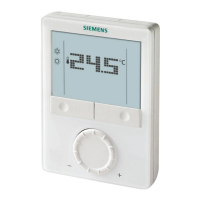15 / 42
Siemens RDG100, RDG100T, RDG110, RDG140, RDG160 Basic Documentation CE1P3182en
Building Technologies Functions 28 May 2009
3076Z03
X2
M
T
X2
M
QAH11.1
T °C
Contact open heating mode
Contact closed cooling mode
The sensor or switch can be connected to the input terminal X2 (factory setting) or
X1 or D1 (switch only), depending on the commissioning of the inputs (P38, P40,
P42).
See also section 4.9 “Multifunctional input”.
The thermost
at acquires the room temperature via built-in sensor, external room
temperature sensor (QAA32), or external return air temperature sensor (QAH11.1)
connected to multifunctional input X1 or X2.
Inputs X1 or X2 need to be commissioned accordingly. See section 4.9 “Multi-
func
tional input”.
Application "Single duct and radiator" can also be used for floor heating.
The temperature should be limited for two reasons: comfort and protection of the
floor. It is only available with application "Single duct and radiator".
The floor temperature sensor, connected to multifunctional input X1 or X2,
measures the floor temperature. If the temperature exceeds the parameterized limit
(parameter P51), the heating valve is fully closed until the floor temperature drops
to 2K below the parameterized limit.
This function is factory-set to OFF (disabled).
Input X1 or X2 must be commissioned accordingly (P38 or P40 = 1).
See section 4.9 “Multifunctional input”.
Living roo
ms:
up to 26 °C for long term presence, up to 28 °C for short time presence
Bath rooms:
up to 28 °C for long term presence, up to 30 °C for short time presence
The table below shows the relation between parameter, temperature source and
temperature display:
Parameter P51
External temp.
sensor available
Source for display of room
temperature
Output control according
to
Floor temp. limit
function
OFF No Built-in sensor Built-in sensor Not active
OFF Yes External temp. sensor External temp. sensor Not active
10...50˚C No Built-in sensor Built-in sensor Not active
10…50˚C Yes Built-in sensor
Built-in sensor + limit by
external sensor
Active
Dewpoint monitoring is essential to prevent condensation on the cooling coil.
It helps avoid associated damage to the building.
A dewpoint sensor with a potential-free contact is connected to multifunctional input
X1, X2 or D1. If there is condensation, the cooling valve is fully closed until no
more condensation is detected, and the cooling output is disabled temporarily.
The condensation symbol
is displayed during temporary override.
The input must be commissioned accordingly (P38, P40, P42).
See section 4.9 “Multifunctional input”.
Extern
al / return air
temperature sensor
Floor heating
Floor heating
limitation function
Recommended values
for P51:
Dewpoint monitoring

